How much time search engine optimization (SEO) takes to start working is always a pressing topic for our potential clients.
The problem in answering that question is that there’s so much noise in digital marketing that many businesses start an SEO strategy with unrealistic expectations because their agency guaranteed they would “rank in three months!”.

Unfortunately, SEO doesn’t work that way.
There’s no governing body in SEO, which means there is an overabundance of opinions and often misinformation that often makes its way into many SEO campaigns. You’ve probably heard the stories of websites ranking within a few months, but the data is often ambiguous, if not flat-out misleading.
There are lots of questions about SEO, and none of them are as tricky to answer as “How long does SEO take?” Multiple variables play a role in how your website ranks and when or even if you’ll see results from your optimization efforts.
Understanding how SEO works and the variables at play are crucial to succeeding in the search engine results page (SERP). You won’t find a super-secret SEO hack to supercharge your SEO, but you’ll get a real answer on how long SEO takes.
Let’s dive right in.
How long does SEO take to work?
The most accurate answer is, it depends.
For most sites, it takes about 2-3 months to rank for low-competition keywords and about 4-12 months to achieve significant success in search. Most SEO agencies will tell you that it typically takes about 4-6 months to rank and while this isn’t false, we commonly see:
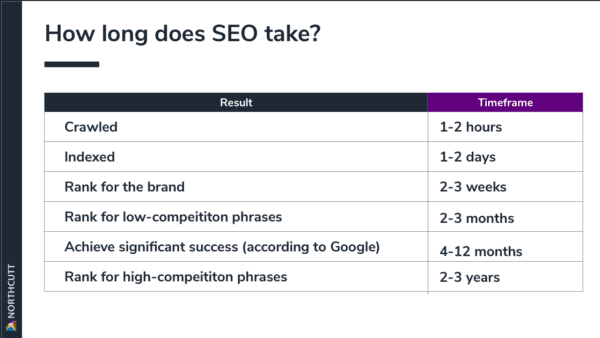
Most brands can expect to see SEO rankings within 2-3 months on low-competition keywords. Google even offers up a timeline, stating that it takes 4-12 months to achieve significant success in search. If you’re attempting to rank on high-competition keywords, we’ve found that you’ll likely see results within 2-3 years.
In spite of these realities, Orbit’s Optimization team has had many clients achieve SEO success long before the 2-3 year mark. Recently, Plum Diamonds increased its organic traffic by 633 percent and sales from organic search by over 700 percent in just six months!
Why does SEO take so long?
Over the years, Google has improved its algorithms and its search engine. In the late 2000s, a lot of “short cut” tactics could propel your search engine rankings (meta keywords, anyone?). But of course, that led to poor user experience for searchers.
Google has vastly improved its UX by continually optimizing its algorithm, and with each optimization, it became more challenging to rank. Quality rules in today’s market and that alone will add to the time it takes for your website to rank.
Let’s take a look at a few factors that will determine how long it takes for you to rank and how low-quality SEO will extend your SEO timeline.
How each pillar of SEO impacts how long SEO takes to work
SEO is nuanced, but at its core, there are three main pillars for finding SEO success. Let’s take a look at each pillar and how they play a role in how long SEO takes to work.
Content
Your content needs to have value. Next to backlinks, quality content is one of the most important factors determining how quickly you’ll rank on Google. Let’s face it: if your content is low-quality, you’re going to be fighting an up-hill battle with your SEO efforts.
You can build thousands of backlinks to your website, but if you’re churning out content that has little to no value from Fiverr, your results will be less than ideal.
Sure, you could head over to Fiverr and order 100 articles from its content farm for $25 a pop intending to add as many pieces of content to the index as possible. But don’t get caught up on word count or the number of pages indexed; neither are ranking factors. Instead, your focus should be on producing content that solves searchers’ issues (aka, matches search intent).
That may be a 500-word article, or it may be a 3,000-word article. The length of your content depends on the topic and what type of content currently ranks (well) on Google for this topic.
You don’t have to pull out your wallet and pay for a shiny new SEO tool to create content that ranks well. Just Google the keywords that you’re writing about and voila!
Be sure to make a note of the structure of their content and the sub-topics covered. Your goal is to create a higher quality piece of content that is unique to you and your business.
Technical SEO
Over the last few years, Google has vastly improved its search engine, and with those improvements came added complexity for website owners. Content and links will move the needle, but if Google can’t properly crawl your site, you’re going to be fighting a losing battle.
Technical SEO is the practice of optimizing your website and infrastructure to help search engines properly crawl and index your website more efficiently.
If Google and other search engines have trouble crawling and indexing your website correctly, you’ll have an uphill battle increasing your organic rankings. The most common Technical SEO issues that we see are:
- Slow page speed
- Poor internal linking and site architecture
- Technical duplicates (www. and non-www. version of your domain indexed)
- Broken links (404 errors)
- Redirect chains
- Crawling, indexing and rendering
- Incorrect Hreflang implementation
Not all of these issues are catastrophic and some of these areas will have a bigger impact compared to others. That’s why prioritization is so important with Technical SEO.
Links (external + internal)
Link building (external) is one of the most important aspects of SEO, and there’s no denying the impact of quality backlinks.
On the surface, link building can appear to be all about volume. The volume of backlinks/referring domains is a factor, but you can’t rely solely on raw numbers.
This is where quality comes into play. You can buy thousands of backlinks from sites like Fiverr and Black Hat World, likely from low-quality domains, and of course, you’re risking your domain using Black Hat SEO tactics.
As Google says, “Any links intended to manipulate a site’s ranking in Google search results may be considered part of a link scheme and a violation of Google’s guidelines.” Google takes this seriously, and you can see why. A quick search on Fiverr gives you 6,411 providers of “backlinking.” There are 3,450 providers charging less than $10. This may seem tempting if you’re looking for a low-cost approach, but…
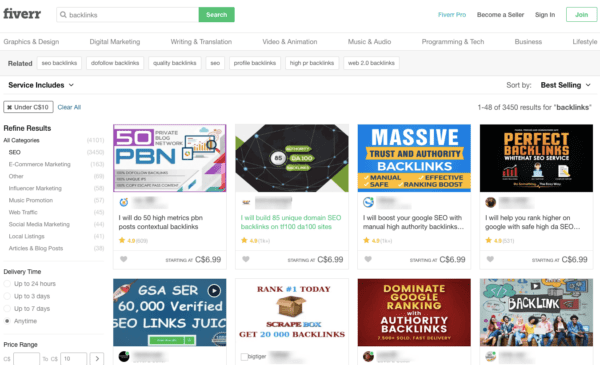
You may see a temporary spike in your rankings, but it won’t last long. You’ll be on top of Mount Google until the next algorithm update thrusts you from the top of the mountain into the depths of the unknown.
Instead of buying links and partaking in Black Hat SEO, you should build high-quality backlinks from authoritative domains.
Internal Links
You’ve heard all of the buzz around backlinks (rightfully so), but most SEOs turn a blind eye to internal links. Internal links pass PageRank and are one of the few ranking factors that you have 100% control over.
Your internal anchor text is also a positive on-page ranking factor and there is no penalty for using exact match anchor text with your internal links. The goal here is to provide Google with as much additional context as possible.
What you link to is equally important. You want to link to relevant sub-pages that support your main topic, commonly referred to as the hub and spoke model. All of your internal links pass PageRank and this model will keep PageRank flowing between your hubs and spokes.
The factors that can extend your ranking timeline
There is no one-size-fits-all SEO strategy. Cookie-cutter SEO doesn’t work because each website is unique, and the variables are different. Taking the same approach to SEO with every website is like trying to solve an algebra equation while ignoring the variables.
If you’re rolling out a new project, it’s going to be a long-term effort. And if you’re working with one of the best SEO agencies, they should communicate this from the start.
If they make promises like guaranteed page-one rankings or their pricing seems too good to be true, run for the door. The truth is, it may take as long as six months to see results. It will be a multi-year effort to compete with the leaders in your space. In other words, this won’t happen overnight.
1. Competition
There was a time when SEO was unknown to most businesses, and the businesses who knew about SEO didn’t place a lot of importance on SEO. This lack of knowledge opened up opportunities for smaller businesses to move up the SERP quickly.
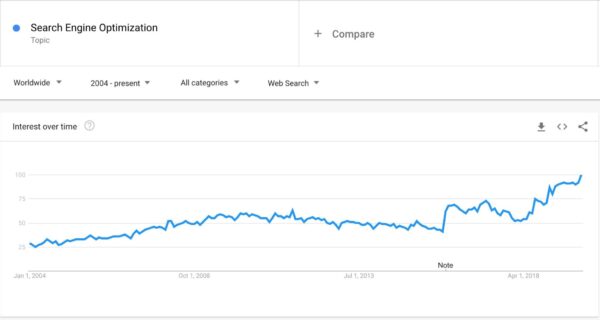
This isn’t the case anymore. SEO adoption has grown, and companies are heavily investing in SEO, building out their in-house SEO teams, and augmenting their in-house teams with agencies to maximize their organic reach.
Think about how much you’re investing in your SEO campaign. Your competition is at least investing as much. The quality of your competition can impact how long it takes for you to see results, and of course, if no one is actively optimizing for your keywords, you’ll see results a lot quicker.
You may be hesitant when deciding whether or not to invest in SEO. However, every week you put off your decision, your competition is still building links and producing content, widening the gap between you and your competition, thus increasing your ranking timeline.
2. Poor keyword research and targeting
Search engine optimization (SEO) has drastically changed since the late-2000s when you could rank by stuffing keywords in meta keyword tags and throughout your landing pages. As search engines improve and SEO becomes more popular amongst marketing teams, ranking becomes a bit harder.
Over the last year, I’ve held meetings with hundreds of brands ranging from small businesses to Fortune 500 companies, and the common theme amongst those who rank poorly is weak keyword research and targeting.
If you want to speed up the timelines above, you have to be surgical with your keyword research and targeting. In my opinion, all brands should focus on the low-hanging fruit right out of the gate, and this low-hanging fruit is what we refer to as long-tail keywords.
Long-tail keywords are less competitive and allow you to answer specific questions that your users are asking directly.
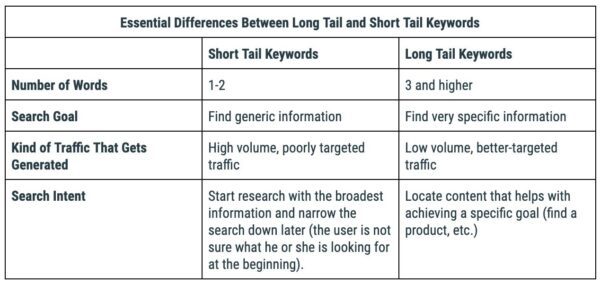
Like SEO, keyword research has changed dramatically over the last five years, and solely relying on keyword research tools to create content is a sure way to set yourself up for failure.
Most of the content that I’ve reviewed over the last year has completely ignored search intent. It’s commonplace among most companies to jump into a keyword research tool, sort by search volume, and then create a lander with the keyword as the H1.
This isn’t enough.
More than ever, Google is an answer engine and wants to provide its users with in-depth answers to their questions. So, once you find a keyword, you need to take it a step deeper and ask yourself, “What is the searcher actually searching for?”
Let’s take a look at a real-life example. Say we want to create a piece of content targeting the long-tail keyword “best credit cards.”
We can infer from the modifier “best” that users are looking for the best credit card options. It would make sense to produce a piece of content outlining several credit cards, their perks, and other relevant information.
Is that enough to rank well? In my opinion, no.
Currently, Nerdwallet ranks in position 1 for “best credit cards” matching search intent above the fold with card recommendations, but if you continue to scroll, you’ll see that Nerdwallet is also answering questions surrounding the topic “credit cards.” How they work, how to apply, how to choose one, etc.
Nerdwallet has built a comprehensive piece of content that satisfies search intent and answers the most common questions surrounding credit cards. Their main competitor, Credit Karma, doesn’t go nearly as deep into the topic, and as a result, they rank in position 7 for “best credit cards.”
Takeaway: Once you know the keywords/topics you want to rank on, take it a step deeper by analyzing the search results to gain insights on intent and the type of content that users and Google expect from publishers. Use this data to inform your content strategy moving forward.
3. Internal pressure and unrealistic expectations lead to low-quality SEO
Here’s a scenario for you: Your competition is outranking you on high-value keywords, and you feel pressure from within your organization to dethrone them in three months. You may want to look for an SEO agency that will tell you they can accomplish this in two months and make all of your dreams come true.
Don’t get caught up with moving 100 miles-per-hour; today, quality matters. Quality backlinks, quality content, and a quality website go a long way in ranking in today’s market.
4. Ignoring your site structure and internal linking
Unfortunately, internal linking is overlooked when asking, “How long does SEO take?” We’ve established how important backlinks are to SEO, but what about the internal links that exist within your website?
It’s important to remember that internal links pass PageRank! The idea is simple but is often ignored. You want to pass PageRank from pages with the highest PageRank to pages with the lowest PageRank How do you do that? Internal Linking.
5. Blindly copying your competitors
Any well-thought-out SEO strategy will include a competitor analysis, as it’s important to understand what your competition is doing and where they are having success.
However, over the last year, we’ve seen this turn into a circle of copycat SEO. Companies produce the same content as their competition only because they rank well, and I understand it.
You’re facing pressure to produce results, and when you have limited time, it doesn’t always make sense to reinvent the wheel.
With that said, you’re setting yourself up for failure by merely copying your competitors. Analyze their content, look for angles that they haven’t explored, and look for ways to go deeper with your piece of content.
6. Ignoring creative SEO
You can deploy creative strategies to ramp up your rankings on low competition keywords. Targeting low competition keywords that have business value can augment your SEO strategy. Creating comparison content works exceptionally well, and it’s targeting the bottom of the funnel, which means this content will convert at a higher clip.
Podia is an excellent example of building out comparison content. These pages don’t have a high number of linking domains (most of them <5 linking domains). However, they all rank well for the branded queries of their competition, and over 10 percent of those who visit become customers.
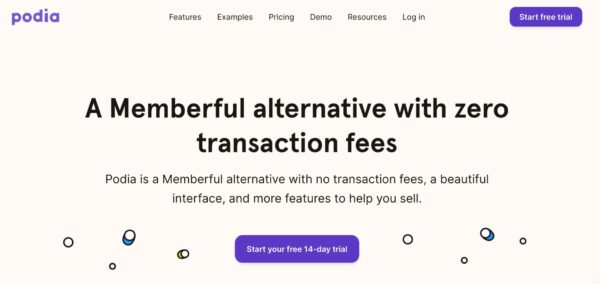
They produced high-quality content that satisfied search intent and augmented that with their internal linking. Podia’s Kajabi comparison page brings in an estimated 2,000 organic visitors per month!
This strategy works exceptionally well because branded queries are often low-competition, and many users search for alternatives.
Regardless of size, this is a strategy that could pull in results within a few months and, most importantly, increase your revenue.
Other Considerations: Avoid common SEO myths
Unfortunately, the SEO industry can be full of noise and misguided recommendations. To wrap this post up, I wanted to explore the common SEO myths so that you can focus on what actually moves the needle.
Content length is a ranking factor
This is one of the biggest myths in SEO. I’m sure you’ve stumbled across this myth in several SEO blogs, where the recommendation is to write at least 2,500 words.
SerpIQ once compared the length of content to top rankings and suggested that 2,000-2,500 words ranked best. Our analysis of Google Analytics across 20+ brands demonstrates that this doesn’t hold up in practice.
Google’s John Mueller also states that Google does not reward word count. Word count can correlate to novelty and links but is not a direct factor.
SEO is a one-time activity
Most brands approach SEO with the mindset that they’ll implement a few changes and their organic performance will take off. This isn’t the case and SEO tools have, unfortunately, boiled down SEO into a check of 10 or 20 things that you can get from a simple audit within their tool.
Look, we get it. These tools definitely have a place in the market, and if you’re building a brand new website, sure, you have to look at this way or you’ll never launch.
But if you want to see lasting results, you have to treat SEO as an investment and the truth is, you’re never done with SEO.
A common question that pops up during consultations is “after you implement your recommendations, we can scale down on focus on maintenance, right?” This isn’t entirely wrong, but until your site is ranking on page one for everything that your business could benefit from, you truly aren’t “done” with SEO.
The truth is, this could be thousands, if not hundreds of thousands of keyword variations. As mentioned previously, SEO is like a math equation and you have control over every single variable at play.
If you’re thinking about investing in SEO, understand that this is a long-term investment and that you’re committing to allocating a % of your marketing budget to achieve long-term results that will grow your business.
SEO is “dead”
I’m not sure if this is a myth, but it’s certainly misleading and pokes its ugly head on a yearly basis. This year, SEO was pronounced dead because of GPT-3 which is an autoregressive language model that uses deep learning to produce human-like text.
For as much as we hear about SEO being dead, you’d assume that companies wouldn’t invest so heavily into search, right?
SEO is more popular now than ever and brands like Nerdwallet and Warby Parker have grown almost exclusively through search.
At Northcutt, we’ve grown revenues for hundreds of companies through search and before I joined Northcutt, SpyFu was largely supported by organic acquisition (SEO, Content Marketing, etc.).
Google Ads will improve your rankings
Unfortunately, you hear this from a lot of PPC agencies, and according to Google, this is one big ole myth.
Sure, running paid ads alongside your SEO efforts may increase the number of clicks you bring in, but there is zero evidence that PPC has any impact on your organic rankings.
With that said, your PPC data is extremely valuable and can inform your SEO efforts. After all, your SEO campaign should be focused on driving conversions, not just traffic.
You must have a sitemap
Sitemaps can be useful, though not required, for the purpose of getting more pages of your site into the Google index. The notion that an XML sitemap will improve rankings within Google is a myth. This comes straight from Google and is confirmed by various studies.
You can view more fact-checked ranking factors here.
Domain age is a ranking factor
Sure, domain age matters, but not how you think. Google isn’t ranking domains solely on domain age and Google’s John Mueller has stated this publically.
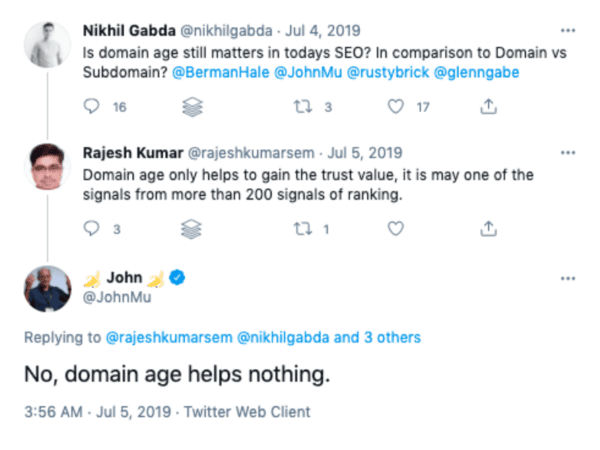
If you’re starting with a new domain, you’ll likely be starting with no backlinks. As outlined above, backlinks are a crucial component in ranking, and gaining quality backlinks from authoritative domains takes time.
Established domains generally rank better when compared to new domains, simply because these domains have links, and have built content over time. Simply put, they have skin in the game.
A study conducted by Ahrefs revealed that the average age of domains ranking within the top 10 results in Google is around two years or more.
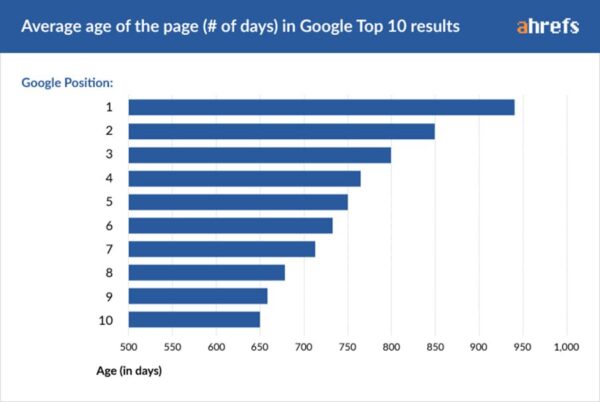
The study also discovered that 95% of newly published pages don’t get to the Top 10 within a year. If you’re starting with a new domain this doesn’t sound promising, but don’t panic! You can rank, but you’ll likely see significant results in 1-2 years, depending on the keywords that you’re targeting.
FAQs
How long does SEO take?
Most brands can expect to see SEO rankings within 4-12 months on low-competition keywords. Google even backs that up, offering up a timeline, stating that it takes 4-12 months to achieve significant success in search. If you’re attempting to rank on high-competition keywords, you’ll likely see results within 2-3 years.
Why does SEO take so long to produce results?
It takes time to produce quality content, to build quality links and you’re actively battling with competitors for the same keywords.
There was a time when SEO was unknown to most businesses, and the businesses who knew about SEO didn’t place a lot of importance on SEO.
This lack of knowledge opened up opportunities for smaller businesses to move up the SERP quickly.
Times have changed, and SEO has evolved. Like all great investments, it doesn’t happen overnight, but the payoff is enormous when you can own the conversation versus renting it with ads.
How much does SEO cost?
This is a frustrating answer, but it depends. What I can tell you is that you should expect to pay a minimum of ~$4,000 per month for quality SEO. In our experience, it’s impossible to take a holistic approach to SEO if a provider is below that floor. Not only will you run into quality issues, but it will be almost impossible to scale.
In the end, make sure that your SEO services provider is transparent and presents a clear outline of how they will hit your goals. If you decide to work with them, hold them accountable, and make sure you have access to the KPIs that they are tracking.
Remember, SEO is not a one-time project. It will take time for you to move up the search results.
Conclusion
SEO is not a one-size-fits-all strategy. Multiple variables will impact how long it takes for your website to rank. Staying consistent is critical. SEO is going to be important to your success even if you don’t see results after three months. Creating and tracking meaningful KPIs will let you know if you’re going down the right path.



